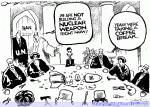QASSIM ABDUL-ZAHRA and ZEINA KARAM
BAGHDAD (AP) — It was a stark message: A convoy of masked Shiite militiamen, armed with machine guns and rocket-propelled grenades, drove openly through central Baghdad denouncing the U.S. presence in Iraq and threatening to cut off the prime minister’s ear.
The ominous display underscored the growing threat that rogue militias loyal to Tehran pose for Iraq. It came at a time when Baghdad seeks to bolster relations with its Arab neighbors and is gearing up for early elections, scheduled for October, amid a worsening economic crisis and a global pandemic.
Last week’s procession also sought to undermine Prime Minister Mustafa al-Kadhimi’s credibility, with Iran-aligned militias driving down a major highway and passing near ministries as Iraqi security forces looked on. Ahead of a new round of talks between the U.S. government and Iraq, it sent a stark warning that the militias will not be curbed.
A fourth round of so-called strategic Iraq-U.S. talks is scheduled for next week after the Iraqi government requested it, partly in response to pressure from Shiite political factions and militias loyal to Iran that have lobbied for the remaining U.S. troops to leave Iraq.
The talks, which began in June under the Trump administration, would be the first under President Joe Biden. On the agenda is an array of issues, including the presence of U.S. combat forces in the country and the issue of Iraqi militias acting outside of state authority. The discussions are meant to shape the future of the U.S.-Iraq relationship, a senior U.S. official recently said.
It is a tightrope for al-Kadhimi, who has said that bringing armed groups under state control is a goal of his administration but finds himself increasingly helpless in reining in the groups. U.S. officials have said Washington will use the meetings to clarify that U.S. forces remain in Iraq for the sole purpose of ensuring the Islamic State group “cannot reconstitute” itself — a signal that the U.S. seeks to keep the 2,500 remaining American soldiers in Iraq.
Political analyst Ihsan Alshamary said the militias’ military-style parade sought to weaken al-Kadhimi’s government and project strength.
“It also aims at sending a message to Washington: We are the decision makers, not the government,” he added.
The militiamen in the parade were mostly from a shadowy Shiite group known as Rabaallah — one of about a dozen that surfaced after the Washington-directed drone strike that killed Iranian general Qassem Soleimani and Iraqi militia leader Abu Mahdi al-Muhandis in Baghdad in January 2020.
Both Soleimani and al-Muhandis were key in commanding and controlling a wide array of Iran-backed groups operating in Iraq, and their deaths in the U.S. airstrike outraged Iraqi lawmakers, prompting them to approve a non-binding resolution to oust U.S.-led coalition forces from the country.
Since then, militias have also become increasingly unruly and disparate. Some Washington and Iraq-based observers argue the militias have splintered into new, previously unknown groups, allowing them to claim attacks under different names to mask the extent of their involvement.
“They are tools used for negotiating purposes and putting pressure on Washington when it comes to (Iran’s) nuclear file,” Alshamary said, referring to efforts under Biden to resurrect the 2015 nuclear deal between Tehran and world powers that former President Donald Trump withdrew from in 2018.
Rabaallah, for instance, is believed to be a front for one of the most powerful Iran-backed factions in Iraq, which the U.S. has blamed for rocket attacks targeting the American Embassy in Baghdad and military bases that house U.S. troops.
Last October, the group set fire to the headquarters of a Kurdish political party in Baghdad and attacked the offices of local media organizations in the capital. It has also been blamed for assaults on liquor stores and an Asian spa center in the Iraqi capital.
Rabaallah went so far as to try and dictate the exchange rate of the Iraqi dinar to the dollar, demanded the approval of a budget and denounced what it said was U.S. “occupation” of Iraq. It displayed posters of al-Kadhimi with a shoe printed across his forehead and a pair of scissors on the side of his face, with the words: “It’s time to cut his ear off.”
Iraq lies on the fault line between the Shiite power Iran and the mostly Sunni Arab world and has long been a theater for settling regional scores. It has also been dragged into the U.S.-Iran proxy war. And though its relations with the U.S. took a hit following the airstrike that killed Soleimani, ties have improved since al-Kadhimi — approved by both Iran and the U.S. — became prime minister.
Political analyst Tamer Badawi said the Shiite militias aim to send a dual message to al-Khadimi’s administration. The first is a warning against any attempt at curbing the militias’ influence under the banner of fighting corruption. The other is to pressure the government to push the U.S. to scale down the number of coalition forces in Iraq.
For his part, al-Kadhimi has tried to curb the militias’ money-making border activities, including smuggling and bribery, and show his American interlocutors that he is capable of keeping domestic adversaries in check.
Badawi said the pressure from the militias will likely increase ahead of the strategic talks with the U.S. on April 7.
In the days after the Rabaallah parade, Iraqi security forces fanned out in the streets and main squares of the capital Baghdad in what a senior Iraqi security official described as a “reassuring message.”
But for Baghdad shopkeeper Aqeel al-Rubai, who watched the February militia parade from the street, the militia show was a terrifying sight that reflects a powerless government.
“I saw that this country is insecure and unfit to live in peace,” he said.
___
Karam reported from Beirut










